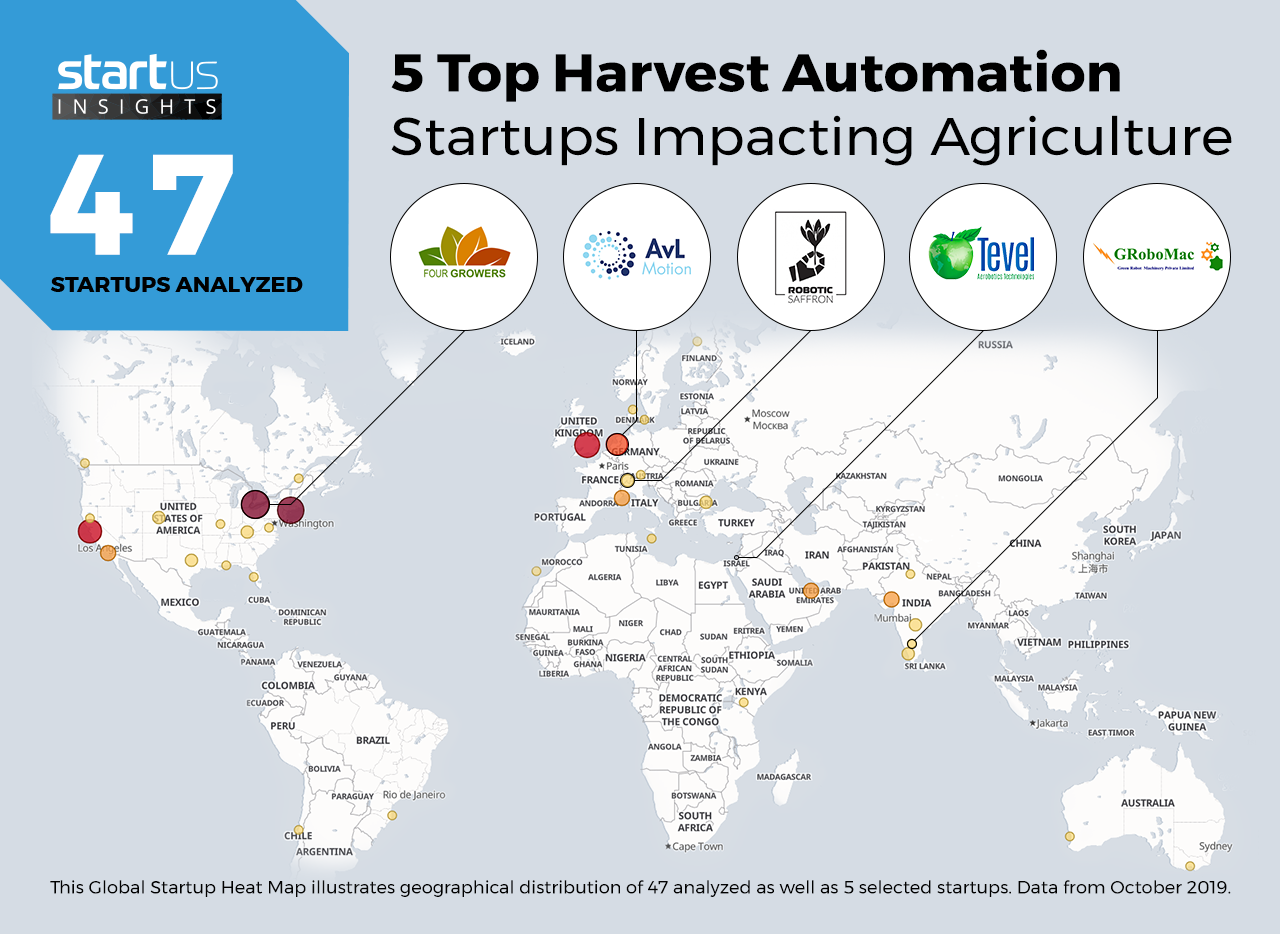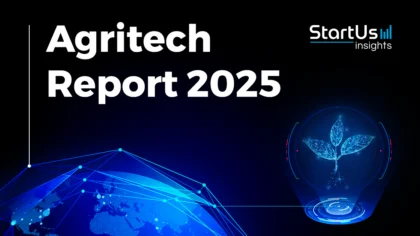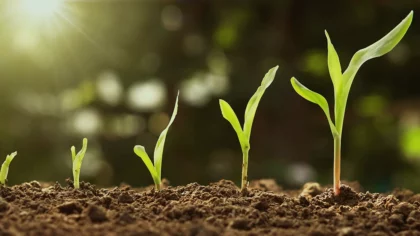Our Innovation Analysts recently looked into emerging technologies and up-and-coming startups working on solutions for the agriculture industry. As there is a large number of startups working on a wide variety of solutions, we decided to share our insights with you. This time, we are taking a look at 5 promising Harvest Automation Startups.
Heat Map: 5 Top Harvest Automation Startups
For our 5 top picks, we used a data-driven startup scouting approach to identify the most relevant solutions globally. The Global Startup Heat Map below highlights 5 interesting examples out of 47 relevant solutions. Depending on your specific needs, your top picks might look entirely different.
AvL Motion – Asparagus Harvester
As robotic technology for the farmer expands in size and variety, there will be a need to create tailored robots to harvest different types of crops. Asparagus is widely consumed across the US and Europe. However, it is one of the most labor-intensive crops when the time comes for harvesting. Since asparagus has to be harvested before it blooms, it requires careful timing to get quality produce. Dutch startup AvL Motion develops robots specifically to address the issue of labor shortages in asparagus harvesting. They are testing a prototype in the field that detects and cuts the asparagus and removes it from the soil. They plan to begin harvesting from the 2020 asparagus season.
Tevel Tech – Soft Fruit Harvester
Soft fruits are small fruits with soft skin like berries, apples, oranges, peaches, pears, and avocados. Manually picking small fruits can be very time-consuming. Orchards and vineyards where these fruits are grown often end up spending a major portion of their resources on just harvesting. In addition to harvesting, the farmer has to then conduct thinning and pruning to ensure that the product is ready for the next stage. Israeli startup Tevel Tech combines an airborne patented robotics platform with sophisticated algorithms to create autonomous drones for orchard harvest and management. They develop a fleet of drones for performing picking, thinning, and pruning tasks in orchards. Their airborne approach provides a holistic harvesting solution to the farmer.
Four Growers – Tomato Harvester
The tomato is an important vegetable – or rather a fruit – in the world, accounting for almost 15% of global vegetable production. It is consumed heavily all over the world. This makes any wastages during tomato harvest difficult to digest. Labor shortages mean farmers pay more to harvest or they just let tomatoes rot in their vines. The US-based startup Four Growers develops automated robots to harvest tomatoes. Currently, their robot can harvest tomatoes inside a greenhouse with future developments focusing on open-field harvesting. They also plan to begin harvesting peppers and cucumbers.
Robotic Saffron – Saffron Harvester
Saffron is a labor-intensive crop. It has three delicate crimson stigmas in the center, which need to be hand-picked, placed on a riddle, and cured over heat to amplify its flavor. Apart from being the most expensive spice, there are many benefits of saffron, which makes it even more special. To put it in context, one gram of saffron costs more than one gram of gold. Italian startup Robotic Saffron develops robots for autonomous harvesting of saffron, keeping in mind the delicate stigma separation process and the high labor costs and shortages. They aim to reduce the prices for this valuable and useful spice through their robotic technology.
GROBOMAC – Cotton Harvester
On average, one human can harvest around 20 cotton plants a day, if they work for 8 to 10 hours. In addition, cotton harvesting by hand can cause allergies or even lasting injuries to the hand. Such facts have forced cotton growers to use machines instead, but this reduces the quality of the cotton fiber. Research and growth in technology have allowed for robotic cotton harvesters. Indian startup Green Robot Machinery develops smart machines to automate some of the tasks done by humans in cotton harvesting. Their machines can be customized to do other labor demanding tasks like weeding, pruning, and spraying. They use a combination of vision technology, artificial intelligence, control, mechanization, mobility, and diagnostics for building their machines.
What About The Other 42 Solutions?
While we believe data is key to creating insights it can be easy to be overwhelmed by it. Our ambition is to create a comprehensive overview and provide actionable innovation intelligence for your Proof of Concept (PoC), partnership, or investment targets. The 5 startups showcased above are promising examples out of 47 we analyzed for this article. To identify the most relevant solutions based on your specific criteria and collaboration strategy, get in touch.









